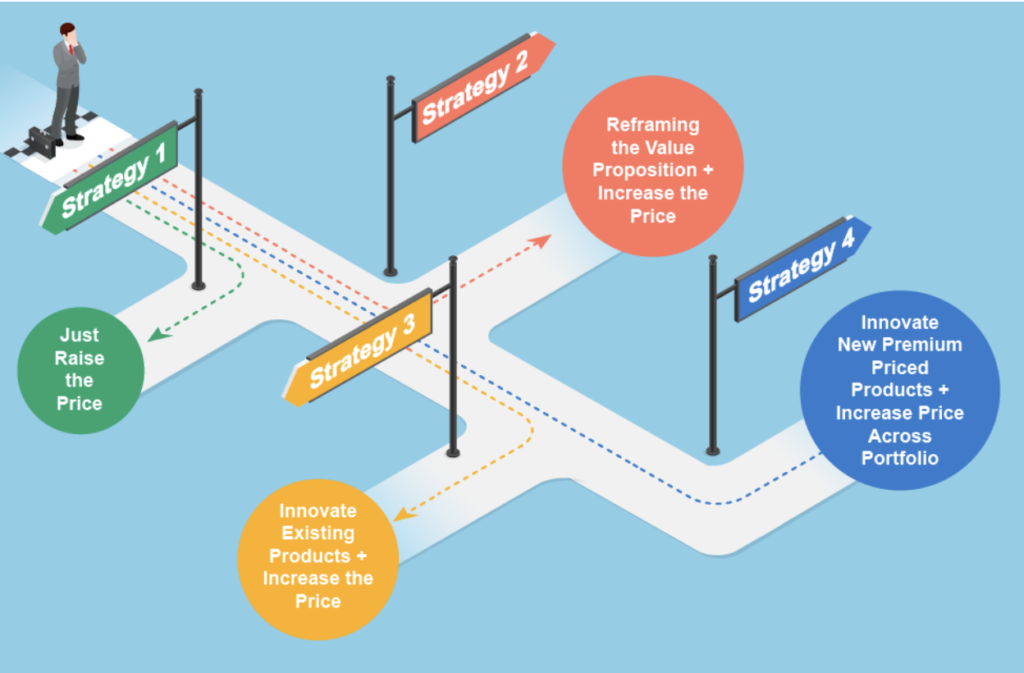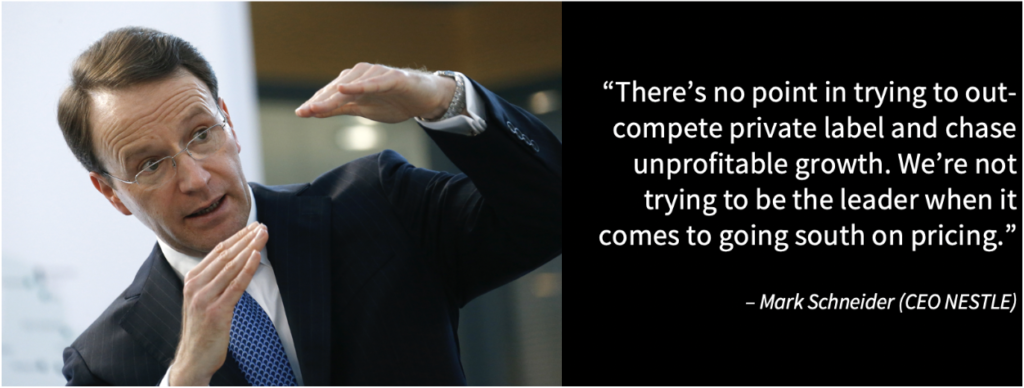In the widely popular blog Premiumization: The Key to Brand Growth, we discussed how big brands are losing customers to private label and store/retail brands (e.g., Amazon “Basics”, Target’s “Good & Gather”, Whole Foods “365″). Traditional approaches, such as penetration and cost-cutting or being different and distinct, are no longer enough to grow in mature markets. We discussed the solution CPG is embracing to win over customers and create sustainable growth. Through the 5 Paths to Premiumization, distinct social, biological, psychological, evolutionary and emotional reasons, brands can get customers to pay premium prices for products.
Premiumization Part 2: Is All About How…
Although premiumization is becoming the widely accepted solution for growth, integrating it has been less than straight forward. Should we add new features or benefits? Should we change the name? Update the packaging? Not change anything? Maybe remove something? Underlying each specific question, the theme is the same…Clients are all asking, “How do we start to premiumize?”
Premiumization Part 2 uncovers a systematic approach for actioning premiumization. We provide a starting point to guide premiumization efforts through prioritizing low cost, least effort changes to add perceived customer value and command margin increases. Before introducing the four approaches to premiumization, we highlight 3 barriers to premiumization…
Premiumization Does Not Start with Innovation
Innovating products is one way to get customers to pay more for products, and it is almost always also a guaranteed way to drive up costs and eat into the premium margin. The key is to not lose sight of the fundamental premise of premiumization, by adding things out of the gate. Starting with innovation is like trying to start a profitable business with loads of debt. Before layering on costs, we have to consider alternative ways to premiumize before adding features and benefits.
Premiumization Is Not About More Revenue But Raising Perceived Value
Many brands are exploring product combinations, increasing pack sizes or offering twin packs which may drive short term sales but can diminish premiumization efforts. Effective premiumization is about increasing customer perceived value to earn more money per unit of product sold (contribution margin). Be cautious about strategies that drive sales, as they may counteract premiumization efforts. For example, twin packs or larger sizes give the perception of ‘value’ and diminish pricing power. The end goal is to drive value and get customers to choose your brand over private label and retail/store brands and pay more for it.
Price Elasticities Are Guides, Not Complete Price Tools
Some say if you increase the price, you will lose your volume. I say if you don’t increase your price you will lose your business. The point of premiumization is to understand what customers value and will pay premiums so we can effectively raise prices. The point is not to get rid of economic tools but to complement them with the psychology of how customers choose.
4 Strategies to Premiumize:
Premiumization is about increasing the perceived value of the product while minimizing the brands’ costs in doing so. To facilitate an actionable path to create brand value with premiumization, we created a systematic approach to guide efforts that breaks down into four strategies:
Strategy 1: Just Raise the Price
Strategy 2: Reframing the Value Proposition + Increase the Price
Strategy 3: Innovate Existing Products + Increase the Price
Strategy 4: Innovate New Premium Priced Products + Increase Price Across Portfolio

Strategy 1 – Just Raise the Price
More and more global brands, such as Nestle, Unilever, Hershey, and Mondelez, are increasing prices to premiumize and protect their reputation from private labels. To command a price premium, the easiest and often overlooked way is simply just raising the price. In a rational world, a price increase needs to be “justified” by consumers, but despite decades of self-report surveys telling us price is a key purchase criterion, behavioral science suggests otherwise.
Here are three reasons a price increase alone may be justified.
- Customers Rarely Remember Prices. In a famous Journal of Marketing study, researchers found that 50% of customers could not correctly name the price of items they had placed in their shopping cart just seconds before being interviewed. Even for frequently purchased products, more than 50% of customers have no idea about prices paid. Limitations in price knowledge open the opportunity to premiumize.
- Higher Prices Signal Better Products. When sorting through cluttered shelves, customers often skip comparing product benefits and look for price to infer quality. Price serves as a ‘mental shortcut’ for quality. Higher prices relative to category competitors signals ‘I am better’, making the choice, in many cases, easier for customers.
- Trusted Brands are Safer Choices. With more product choices, the risk and uncertainty with changing a choice make reputable brands the safe choice and worth an extra price.
Strong brands that have relevant value propositions should consider the upsides and consequences of just raising prices. However, many brands cannot sustain raising prices alone due to market conditions (declining share, lack of relevancy, intense competition, etc.). For example, Heinz, a declining brand that is losing relevancy, should look to strategies 2, 3 or 4 to premiumize.

Strategy 2 – Reframe the Value Proposition + Increase the Price
Many legacy brands got where they are because they are really good at what they do. We all want the next big breakthrough innovation but what most brands need to premiumize is to increase relevancy with customers’ evolved expectations. For example, customers don’t just wear clothes for looks but now also for comfort. Food is now eaten for taste but also to not kill our waistline. And cleaning supplies should not only clean but not spread chemical warfare on our kitchens.
Premiumization strategy 2 is about small, subtle changes in framing the value proposition to increase relevance with customers’ evolved expectations and command price premiums in doing so. Refreshing a package label, adding heuristic buying cues, curating a more relevant value statement, or simplifying cluttered labels are some of the executions used to reframe the offering. To premiumize via reframing the value proposition consider:
- Using the 5 Paths to Premiumization to Identify Untapped Value:Customers don’t just pay extra for more features or benefits. We identified 5 distinct drivers that are based on fundamental needs that customers are willing to pay more for which can be utilized to create and frame new value for customers.
- Communicating Value both explicitly and implicitly: Reframing the value proposition can occur via implicit and explicit product marketing cues without actual substantial product changes. For example, by adding green or brown color accents to packaging brands can cue healthy (implicitly), or by directly communicating “natural” or “non-GMO” (explicit) can simplify choice and capture premium price points.
By finding new value hooks via the 5 Paths of Premiumization and communicating the product better delivers on them (both implicitly and explicitly) you can create new value.

Strategy 3 – Innovate Existing Products + Increase the price
The third way to premiumization is by innovating products to add more value and increase the willingness to pay. Innovating, through adding new features or benefits, is an easy way to create perceived value, but faces 2 challenges that need to be overcome:
- How do we create additional features/benefits (perceived value) at the lowest cost? Adding significant costs to products (even if customers pay more for them), offsets the purpose of premiumization. Remember, the goal of premiumization is to increase perceived value and willingness to pay at the lowest possible cost to increase margins on every unit sold.
- How do we execute and communicate that new value? Once a new feature/benefit is uncovered, what is the best way to frame and communicate the new benefit to drive willingness to pay? For example, fat-free may be what is valued but the difference between 99% fat-free and 1% fat can significantly impact the perception of value. Premiumization execution matters!
Before brainstorming sessions or adding features or benefits, deeply understand the 5 Paths to Premiumization to understand what customers are willing to pay more for. By identifying the path customers are willing to pay more for in your category and not addressed by competition can create sustainable competitive advantages.
Strategy 4 – Innovate New Premium Priced Products + Increase Pricing Across Portfolio
The fourth premiumization play is to add premium products to the portfolio and increase the pricing of the existing product lines. The net result is the premiumization of the portfolio. The new high price point product introduction halos the other products in the portfolio and adds equity to the current line.
For example, in 2014 Nike took this strategy, innovating new athletic footwear at premium price points and prices started increasing on other items in their portfolio.






